Wing flapping of aquatic species is a common behavior that I find difficult to photograph well for a variety of reasons.
- Distance from subject is critical. When those wings come out it’s very easy to clip them if you’re just a little too close but when you’re too far away you lose critical detail.
- Angle on the bird. I find a side view from slightly in front of the subject to be most appealing but that doesn’t happen very often. And some birds rotate in the water during the performance so if you have a good angle you can lose it and vice versa.
- Some species habitually turn their back to the photographer just prior to a wing flap (Pied-billed Grebes for example). I can only guess as to why they do it but they usually do, especially when you’re close.
- Sufficient shutter speed. Wings move very fast and typically when we’re photographing a bird swimming slowly on the water we don’t have enough SS to freeze the wings when the flapping begins. And when that might happen is almost completely unpredictable. In this series I had more SS than I needed but better too much than too little. 1/2500 probably would have been sufficient but I like some wiggle room when I can get it.
- Good light and a low perspective on the bird contribute immensely to the appeal of the image and both are often unobtainable when the performance begins.
I was pleased with this series because all of those factors came together for me. All images are presented in the order they were taken.
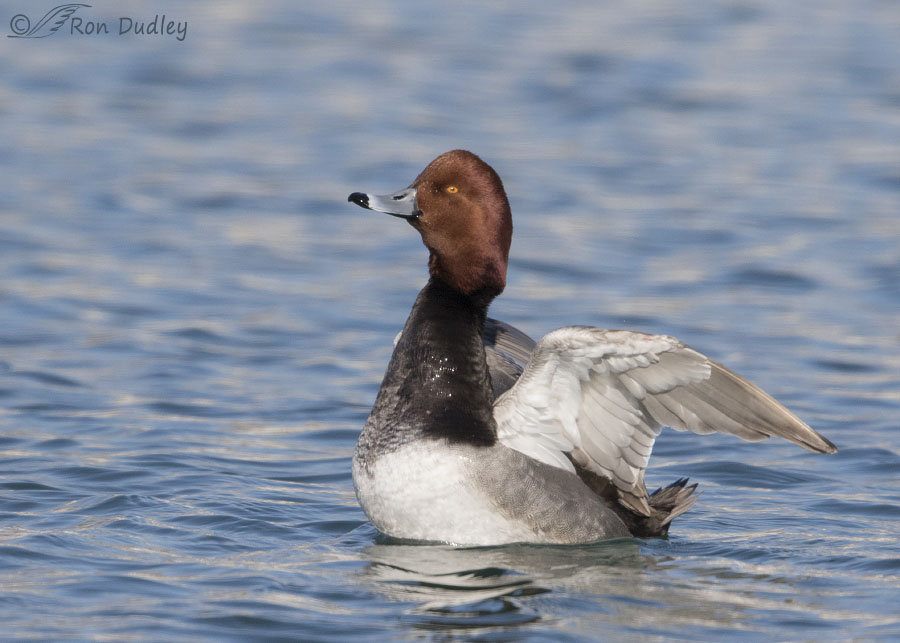
1/4000, f/6.3, ISO 800, Canon 7D Mark II, Canon EF 500mm f/4L IS II USM + EF 1.4 III Extender, not baited, set up or called in
Our recent snow and bitter cold have finally enticed a few birds to “my” local pond besides the ubiquitous domestic ducks, gulls, coots and a few geese. Yesterday afternoon this male Redhead was one of them and he performed a nice wing flap at an appropriate distance and appealing angle. Here he’s just beginning to rise up out of the water and raise his wings.
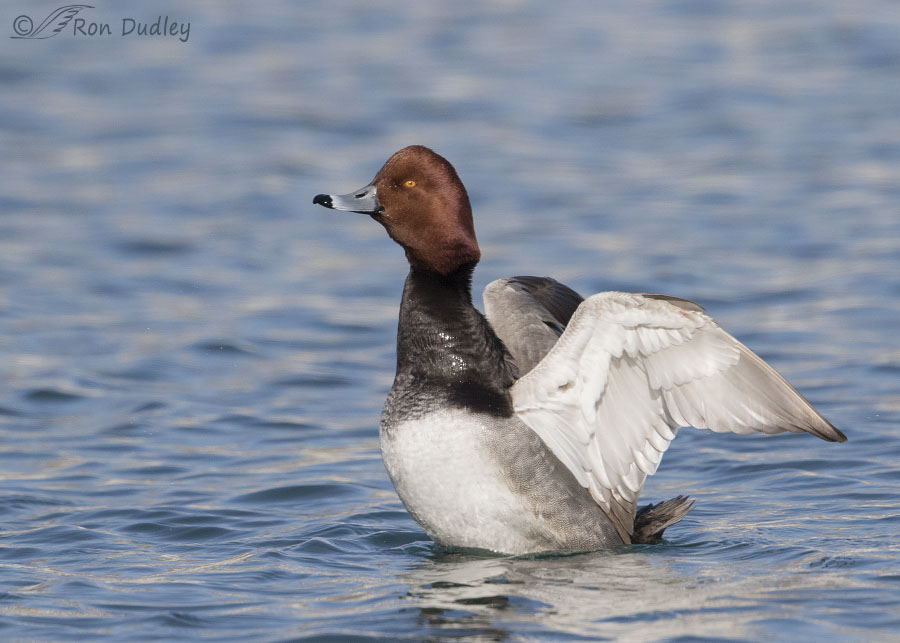
1/4000, f/6.3, ISO 800, Canon 7D Mark II, Canon EF 500mm f/4L IS II USM + EF 1.4 III Extender, not baited, set up or called in
Those wings were already moving very fast but I had more shutter speed than I needed to prevent any motion blur.
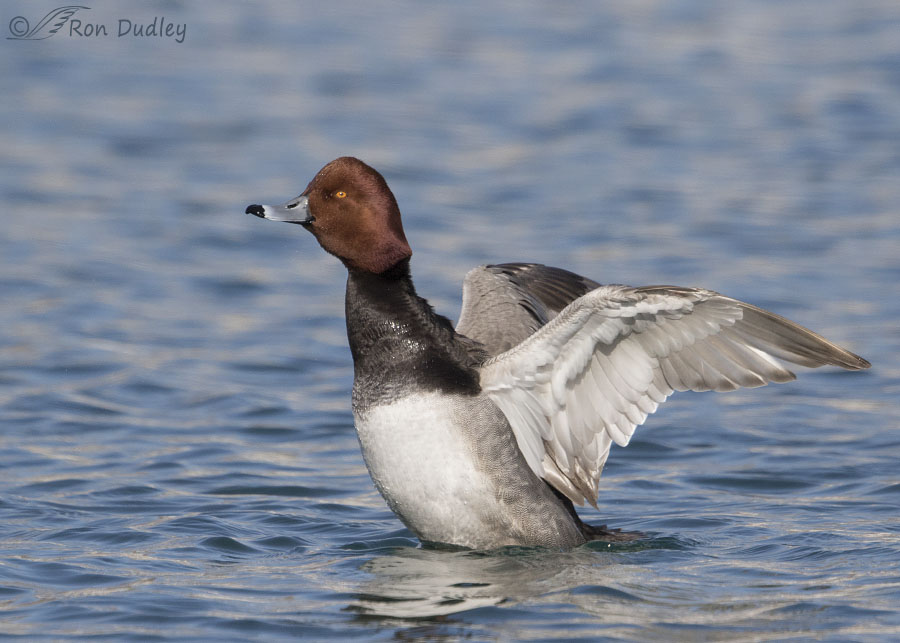
1/5000, f/6.3, ISO 800, Canon 7D Mark II, Canon EF 500mm f/4L IS II USM + EF 1.4 III Extender, not baited, set up or called in
As they often do he began to lean forward to counterbalance the lift from his flapping wings. Otherwise he might tip over backwards in the water.
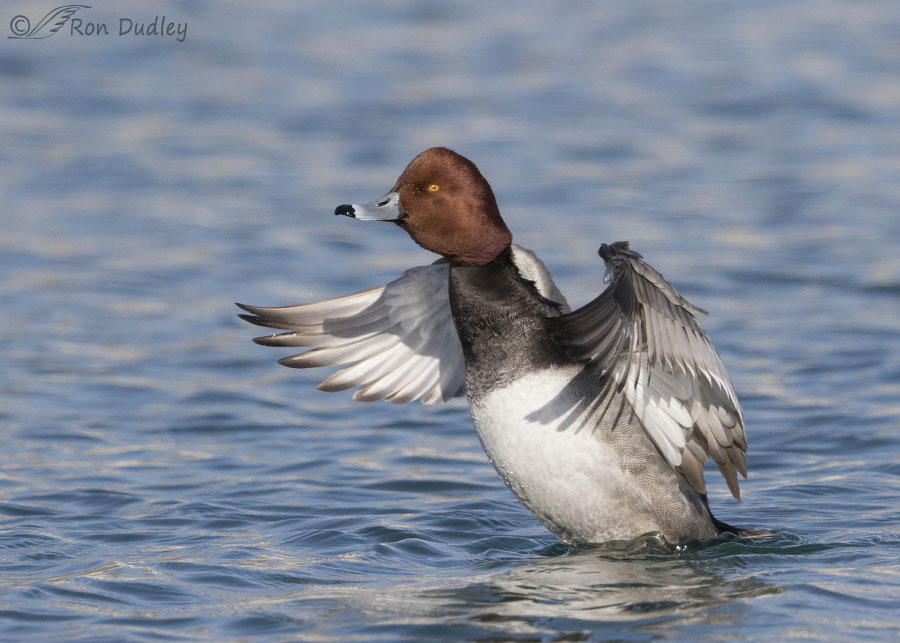
1/5000, f/6.3, ISO 800, Canon 7D Mark II, Canon EF 500mm f/4L IS II USM + EF 1.4 III Extender, not baited, set up or called in
I like the shadow of his head on his right wing.
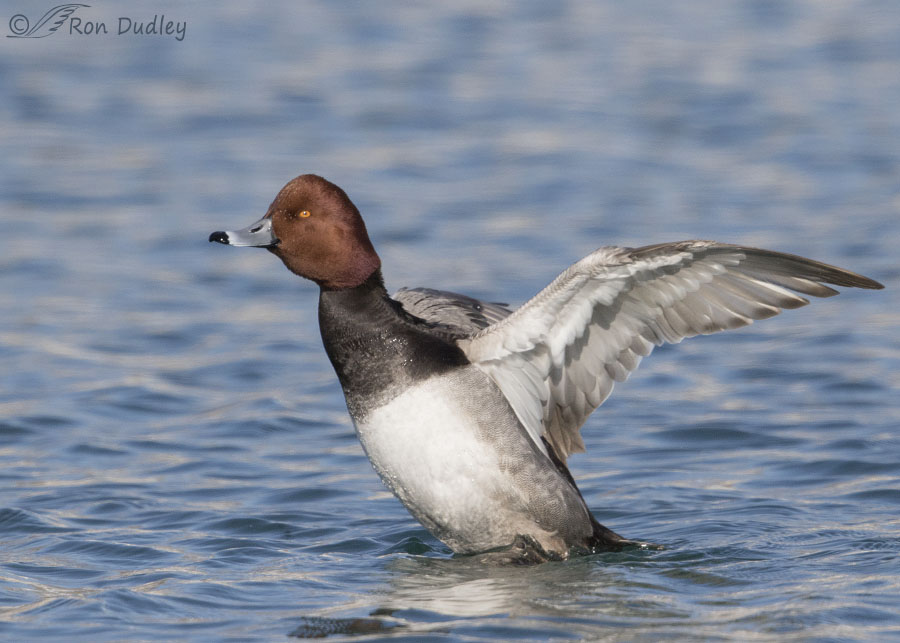
1/5000, f/6.3, ISO 800, Canon 7D Mark II, Canon EF 500mm f/4L IS II USM + EF 1.4 III Extender, not baited, set up or called in
By chance the timing of my shutter and his flapping wings gave me more photos with his wings in this approximate position than any other.
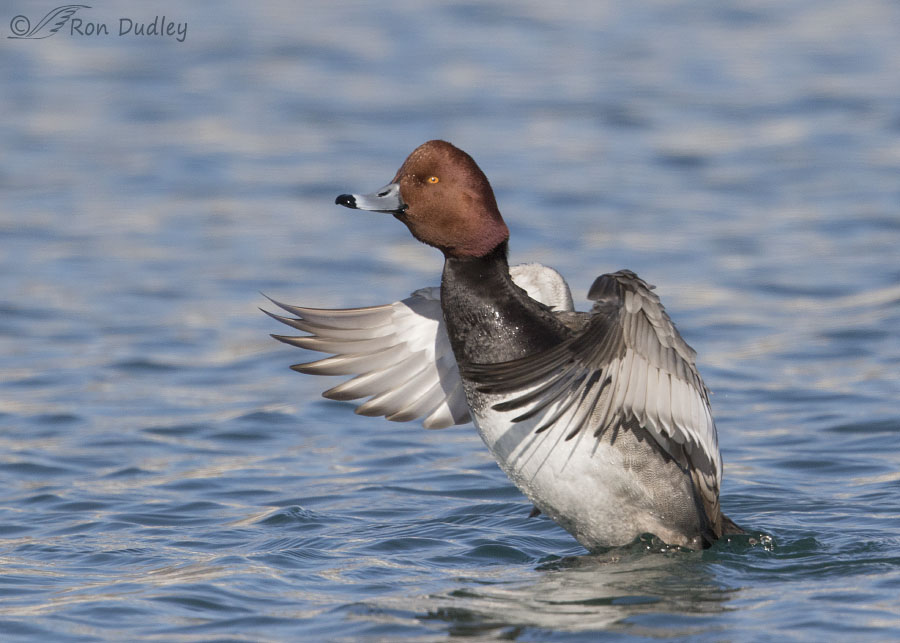
1/5000, f/6.3, ISO 800, Canon 7D Mark II, Canon EF 500mm f/4L IS II USM + EF 1.4 III Extender, not baited, set up or called in
Here we see the flexibility of his wing primaries as they’re bent and curved in response to resistance from the air.
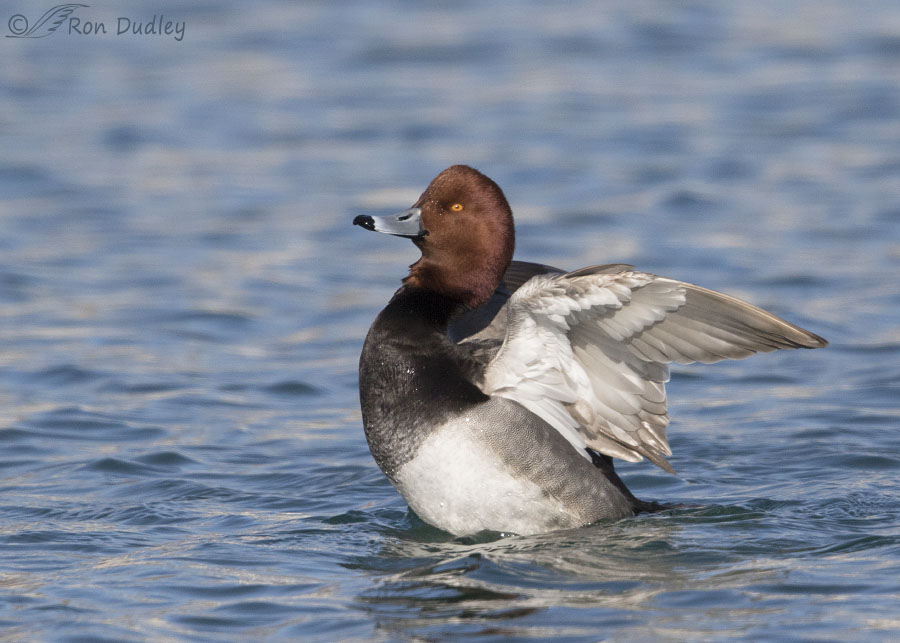
1/8000, f/6.3, ISO 800, Canon 7D Mark II, Canon EF 500mm f/4L IS II USM + EF 1.4 III Extender, not baited, set up or called in
Near the end of the performance he began to settle back down into the water…
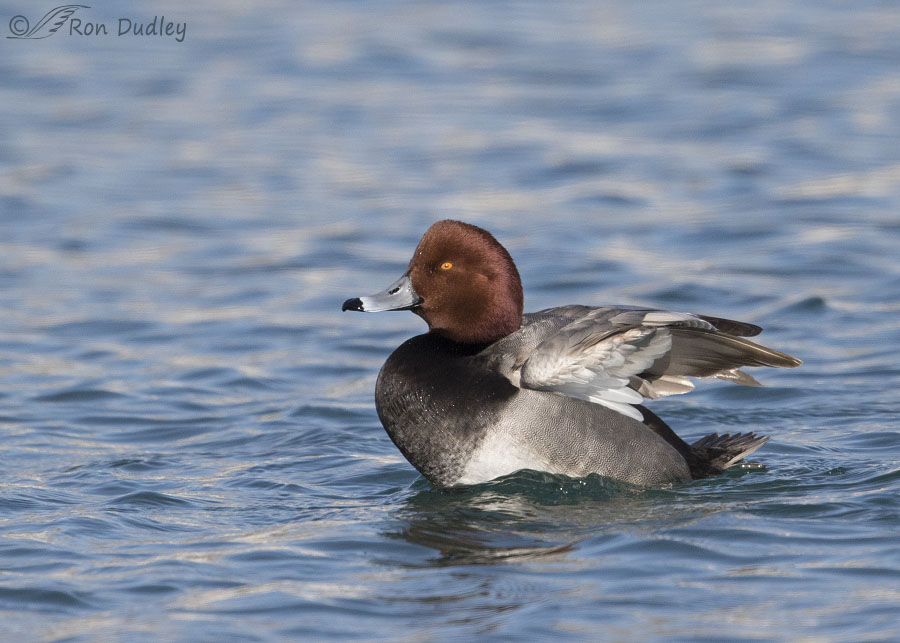
1/5000, f/6.3, ISO 800, Canon 7D Mark II, Canon EF 500mm f/4L IS II USM + EF 1.4 III Extender, not baited, set up or called in
and fold his wings back into a resting position.
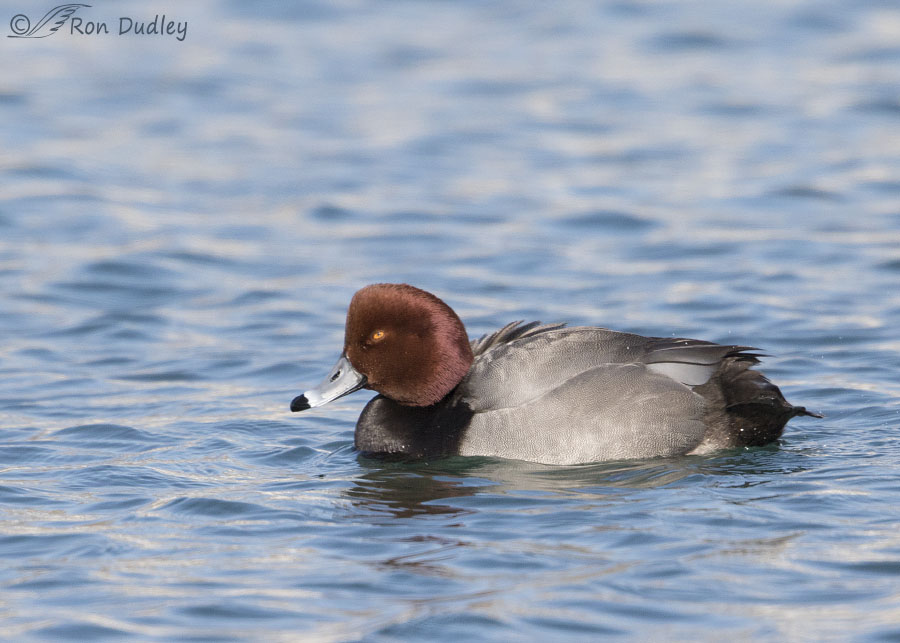
1/3200, f/6.3, ISO 800, Canon 7D Mark II, Canon EF 500mm f/4L IS II USM + EF 1.4 III Extender, not baited, set up or called in
An instant later he was a lazy looking laid-back duck again. Almost immediately after the wing flap he swam away and never returned while I was there.
With most ducks wing flapping is a common occurrence but many things have to come together to photograph it well. This time I was pleased with my results and I even had a handsome subject. This single bird made the trip down to the pond worth the effort
Ron


What a beauty of a bird. Good series of wing flapping. The last picture the bird has a look like “that felt so good!)
Thank you, Jean.
Beautiful photographs all – it’s hard to pick a favorite! Guess I’ll go with #4. I love how he’s looking right at you in all of them.
Thanks, Joanne. Eye contact makes a very big difference.
Glad you got out there for a brief respite from your maladies. You got the double whammy of the shingles over your poor bad back. Major suckitude! 🙁
These shots are gorgeous. I think he knew that you needed a “good’un” and happily obliged. 🙂 I am especially fond of the “butt ruffle” shots, #5 where it looks like he’s about to stand on the surface of the water, and, of course, #4 with the head shadow on the wing and the wing shadow on his body.
I found out that my “wing flaps” are stronger than I thought. I was picking up after the dog this morning, bumped the dead 10′ nectarine tree with my arm and managed to knock the damn thing over from the base of the trunk. Fortunately, I caught a limb and was able to set it down gently. Sure woke me up! 😉
Ouch, bet that hurt, Marty. Thank you.
Hurt the tree much more than it hurt me! 😉
What a lovely series! And I fully appreciate the degree of difficulty including the irritating habits of wing-flapping ducks/birds, available light, distance, camera settings and the pain of just being there to capture these wonderful images. But isn’t it wonderful to be out there where there’s little time to think about anything else but getting those images?
Just thank you for being out there!
Thank you, Laura. And yes, it is.
Ron, in the shots of the bird with his wings up, there is a series of long white feathers on the underside of the wing, close to the body. Any idea what those are called?
Sallie, I think they’re called the axillaries.
Thanks, Ron. I think you’re right.
Great series of shots. I noticed your SS variations – were you actually able to scroll from 1/4000 to 1/8000 during this sequence? If so, I would like to hear more of your technique. Thank you.
Elmer, I shoot in aperture priority so my SS varies automatically with lighting conditions and brightness of my subject and/or background. Even the whites on the underside of wings can change my SS significantly.
Fantastic series Ron!
Charlotte
Thanks, Charlotte.
It’s only right that you’re getting much more than distraction in taking yourself out and around and making the effort to accomplish your work instead of feeling “discomfort”–
only those who’ve had it know what an understatement that is——I’m glad we get to share in seeing the reward for your discipline–thanks for this beauty !
“only those who’ve had it know what an understatement that is”
I can tell that you “get it”, Kris. I sure didn’t until this experience. Thank you.
Ron: Thank you! Each of the nine images is interesting and a pleasure to look at. But the fourth image is special – not only does it hint at takeoff, that head shadow is just fantastic!
That’s one of my favorites too, Richard. Thanks.
….and you should be pleased with those shots Ron! Thank you so much for these magnificent shots of a Duck that I have never seen. What would I do if you didn’t share…hmmmm…don’t know?
And what would I do if folks like you didn’t appreciate seeing them, Shirley… 🙂 Thank you.
Excellent work Ron, once again, and a lucid use of the language. I wonder if you set up your ISO manually to 800 in advance or whether it was in automatic.
I set ISO manually, Ricardo. I shoot in aperture priority so my SS varies with the light and even the pose of the bird so I try to give myself some wiggle room.
However, in this case I didn’t have time to adjust any settings. This bird was close to shore when I pulled up in my pickup and the wing flap began immediately after. I barely had time to stick my lens out the window and fire away, hoping that my settings would work out. They weren’t perfect for the situation but this time I was lucky.
Your comment about my “lucid use of the language” means a lot to me. I work hard at that but I only know if I’m successful from comments similar to yours. Thank you.
The second photo features all the details of the wings fairly spread, the neck extended, and that cute little tail sticking up out of the water. Gorgeous! I applaud you’re getting out regardless of how you feel, but hope it’s a sign you’re feeling better.
I’m glad you mentioned that “cute little tail”, Nancy. My eye is drawn to it in that photo too. Going down to the pond helps to take my mind off of unpleasantness.
Gorgeous bird and shots, Ron! 🙂 #4 with the shadow of his head on his wing and other left wings feather shadows REALLY at to the photo. Primaries on the left wing also bend a lot in that photo! Amazing how flexible those feather are…….. 🙂 Hope the shingles issue is abating for you………..
Thank you, Judy. Not much abatement yet I’m afraid. This is a long haul condition…